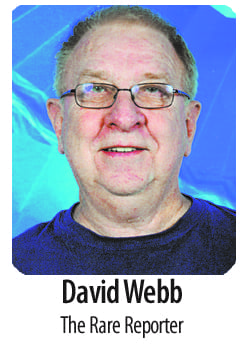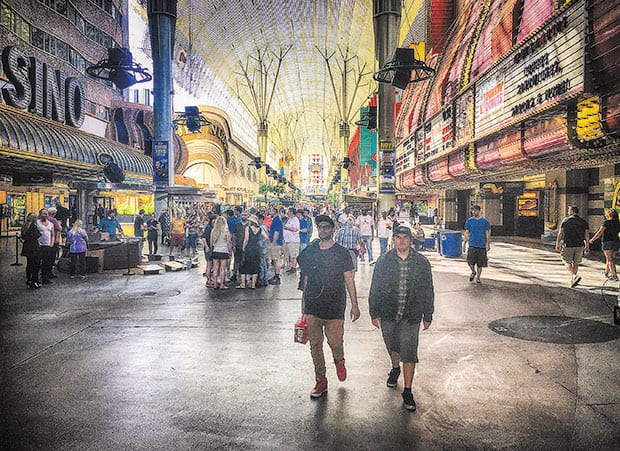Las Vegas lives up to its reputation, just don’t stay too long!

Only a winner’s occasional whoop interrupts the bells and whistles accompanying the flashing lights of the slot machines. Piles of chips multiply and vanish on green, felt-covered tables as waitresses walk the aisles, chirping, “Cocktails anyone?”
As clouds of smoke rise above them, gamblers nervously eye the dice rolls, spinning roulette wheels and falling cards. Newcomers eagerly wait for a loser to bust or a winner to cash out so they can take their places.
 The amount of money flowing out of the players’ wallets and purses is mind-boggling, but no one seems fazed by the display.
The amount of money flowing out of the players’ wallets and purses is mind-boggling, but no one seems fazed by the display.
This is downtown Las Vegas, ground zero of the renowned premiere adult playground, also known as Sin City and the largest gambling mecca in the world. The gritty scene inside and outside the casinos in the entertainment district, known as the Fremont Street Experience, rival New Orleans’ French Quarter. The party rocks all night, all week long.
In recent years, word drifted across the country that the old Las Vegas, the one where tourists felt free to indulge in wretched excess of every kind, no longer existed. That’s not true in the center of the city.
The giant casino hotels on the Las Vegas Strip — the ones that feature the big concerts and other shows — embrace a cleaner, more wholesome atmosphere. But Fremont Street remains as wild and crazy as ever.
When the guests at the large casino hotels want to indulge in a little hedonism, they climb on board the shuttle that runs between the Strip and downtown in search of more excitement. The most popular spot features four aging casino hotels on corners facing each other: the Four Queens, the Fremont, the Golden Nugget and Binion’s.
There they find virtually naked men and women standing on the pedestrian-only street, promoting commercial and personal agendas. Two of the more unusual posers stood out in the raucous crowd: a woman wearing the headdress of a nun, pasties, a black bikini bottom and high heels, and a man wearing only a pink thong. Both sought “tips.”
Two women wearing the briefest leather outfits and military-style hats emblazoned with the word “Police” presumably did not really serve on the Las Vegas Police Department. But who knows in this entertainment district? Across the street two “bunnies,” complete with ears and tails on their nearly naked backsides, promoted a nightclub.
Saying that Las Vegas is gay-friendly is almost unnecessary. Nothing seems to matter much to anyone in this area. It has got to be the impetus of the “What happens in Vegas stays in Vegas” slogan.
The only thing you won’t find on Fremont Street is kids. The hotels above the casinos are nice, but the district gets loud late at night. The street is covered by a canopy, and it features a zip line at the top for anyone daring enough to seek that high rush.
It’s clear why so many visitors to Las Vegas go for only three nights; a longer visit might not only bankrupt, it would leave you thoroughly exhausted. The body can only take so much punishment, and the bank account is likely to give out even faster.
That’s when the entertainment venues on the Strip become more appealing to gamblers.
Only Las Vegas can provide a forum for big-star performances like Cher, Britney and Ricky Martin and their prop-heavy, sensational shows in enormous theaters. Cirque du Soleil recently staged a performance of “Love,” featuring Beatles music, at the Mirage with heavy emphasis on “Sgt. Pepper’s Lonely Hearts Club Band.”
No one lucky enough to be there will ever forget the props and performances by the acrobats, dancers and singers.
A cab ride to the Monte Carlo to see the Cher show became as entertaining as everything else in Las Vegas. The cab driver also worked as a dealer in one of the big casinos, and he shared his knowledge of Las Vegas. He said while Sin City is best known for gambling, the biggest income generator has become the shows and conventions. For every guest staying in the casino hotels, there are two employees. Retail stores and restaurants surround the hotel casinos on the Strip and spread out for miles.
The population of Las Vegas grew dramatically during the 1900s, in large part because gambling and other entertainment income allowed Nevada to forego a state income tax. Property taxes are also low, adding to the state’s appeal. Additionally, corporations got income tax breaks so many businesses not associated with gambling and entertainment grew, too.
Other things to see
When the casinos and the shows both become too much, Las Vegas offers the Smith Center for the Performing Arts and Discovery Museum in Symphony Park, the Neon Museum, the Las Vegas History Museum, the DISCOVERY Children’s Museum, the Nevada State Museum and the Old Las Vegas Mormon State Historic Park.
The Downtown Arts District, with numerous galleries, hosts the annual Las Vegas Film Festival, and First Friday is a monthly celebration featuring exhibits of art, music and food. The celebration typically extends into the Freemont entertainment district, bridging culture and revelry.
Hoover Dam is another popular tourist draw, and tours of the Grand Canyon and the Mojave Desert (including a ghost town) are available.
So it is a diverse city. Nevertheless, Las Vegas will forever be linked with entertainment. Many of Las Vegas’ residents never step foot in the casinos, but few people who visit Sin City are able to resist the lure of the slot machines and tables.
It’s the sort of experience most people like to try at least once.
David Webb is a veteran journalist with more than three decades of experience, including a stint as a staff reporter for Dallas Voice. He now lives on Cedar Creek Lake and writes for publications nationwide.
This article appeared in the Dallas Voice print edition May 26, 2017.

